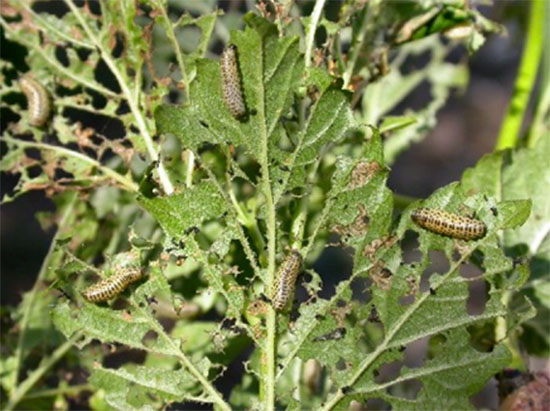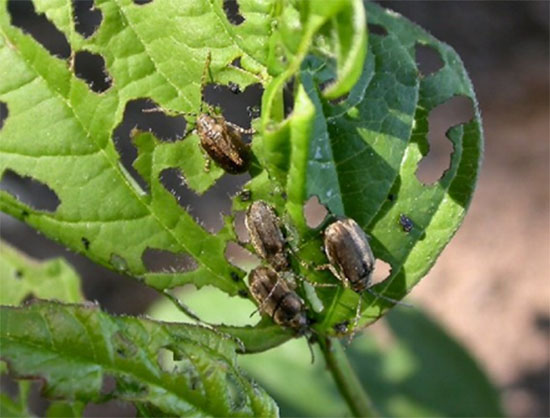Issue 7, June 8, 2015
Viburnum Leaf Beetle Activity Reported
Reports of viburnum leaf beetle injury continue to come in out of Cook and DuPage counties. A relatively new pest in Illinois, we saw feeding begin to be more noticed in 2014. That trend continues this summer.
Over the past two weeks we have had several emails and calls concerning the defoliation of viburnum. Larvae typically hatch from overwintered eggs in May. They feed on host plants, primarily on the undersides of leaves, skeletonizing the foliage, leaving only midribs and major veins intact. Mature larvae drop to the ground, enter the soil and pupate. By early July, adults will emerge and also feed on viburnum foliage. Development from egg hatch through adult emergence generally takes 8 to 10 weeks.

Viburnum leave beetle larvae and damage. (Todd Murray, WSU)
Adult feeding will vary from the injury caused by the larvae. Injury caused by adult viburnum leaf beetles consists of irregular circular holes in the leaves. Adults will continue to be active throughout the summer until the first killing frost. Females will chew holes in small branches or twigs of viburnum (usually the current year's growth) and deposit several eggs into the cavity that will overwinter.

Viburnum leaf beetle adults and damage. (Todd Murray, WSU)
Feeding is limited to species of viburnum. The viburnum leaf beetles have a preference for viburnums with little hair (pubescence) on the foliage, including the European cranberrybush viburnum, arrowwood viburnum, and American cranberrybush viburnum. They also feed on wayfaringtree viburnum, Rafinisque viburnum, mapleleaf viburnum, nannyberry viburnum, and Sargent viburnum. There are several resistant varieties, including Koreanspice viburnum, Burkwood viburnum, doublefile viburnum, Judd viburnum, lanatanaphyllum viburnum, and leatherleaf viburnum.
Preliminary list of viburnum that are relatively susceptible or relatively resistant to viburnum leaf beetles (compiled by Dr. Paul Watson, Cornell University).
Highly susceptible:
- V. dentatum complex, arrowwood viburnums
- V. nudum, possum-haw, smooth witherod viburnum
- V. opulus, European cranberrybush viburnum
- V. opulus var. americana (formerly V. trilobum), American cranberrybush viburnum
- V. propinquum*, Chinese viburnum, Taiwanese viburnum
- V. rafinesquianum, Rafinesque viburnum
Highly susceptible species are the first to be attacked, and are generally destroyed in the first 2-3 years following infestation.
Susceptible:
- V. acerifolium, mapleleaf viburnum
- V. lantana, wayfaringtree viburnum
- V. rufidulum, rusty blackhaw, southern black-haw
- V. sargentii, Sargent viburnum
- V. wrightii, Wright viburnum
Susceptible species are eventually destroyed, but usually are not heavily fed upon until the most susceptible species are eliminated.
Moderately susceptible
- V. alnifolium (syn. V. lantanoides), hobblebush
- V. burkwoodii, Burkwood viburnum
- V. x carlcephalum, Carlcephalum viburnum
- V. cassinoides, witherod viburnum
- V. dilatatum, linden viburnum
- V. farreri , fragrant viburnum (except 'Nanum', which is highly susceptible)
- V. lantanoides (syn. V. alnifolium), hobblebush
- V. lentago, nannyberry viburnum
- V. macrocephalum, Chinese Snowball Viburnum
- V. x pragense, pragense viburnum
- V. prunifolium, blackhaw viburnum
- V. x rhytidophylloides, lantanaphyllum viburnum
- V. tinus*, laurustinus viburnum
Moderately susceptible species show varying degrees of susceptibility, but usually are not destroyed by the beetle.
Viburnum most resistant to the viburnum leaf beetle:
- V. bodnantense, dawn viburnum
- V. carlesii, Koreanspice viburnum
- V. davidii*, David viburnum
- V. x juddii, Judd viburnum
- V. plicatum, doublefile viburnum
- V. plicatum var. tomentosum, doublefile viburnum
- V. rhytidophyllum, leatherleaf viburnum
- V. setigerum, tea viburnum
- V. sieboldii, Siebold viburnum
Resistant species show little or no feeding damage, and survive infestations rather well. Most species in all susceptibility groups exhibit more feeding damage when grown in the shade.
(Source: http://www.hort.cornell.edu/vlb/suscept.html)
In regards to management options, Cornell has a very helpful management guide for homeowners (http://www.hort.cornell.edu/vlb/manage.html). At this time of year, for homeowners who are experiencing defoliation, the best option is going to be pesticides. It is important to make sure larvae are present and to make a thorough application so the pesticide comes in direct contact with the larvae. Spraying adults or eggs is less effective. There is some information on the use of horticultural oils and insecticidal soaps (http://www.hort.cornell.edu/vlb/newtools.html).
The viburnum leaf beetle, a native to Europe, was brought to North America on infected viburnums. While it is established in several northeastern states, we've only confirmed this pest in two counties in Illinois. If your viburnum plants are showing signs of defoliation, please keep your eyes open for larvae now or Viburnum Leaf Beetle adults in the next few weeks. Residents are urged to report suspected infestations; we are continuing to gather information on where this pest is in Illinois. If you see this pest or have questions, please contact or Kelly Estes at the Illinois Natural History Survey - Cooperative Agricultural Pest Survey kcook8@illinois.edu. (Kelly Estes)
Author:
Kelly Estes